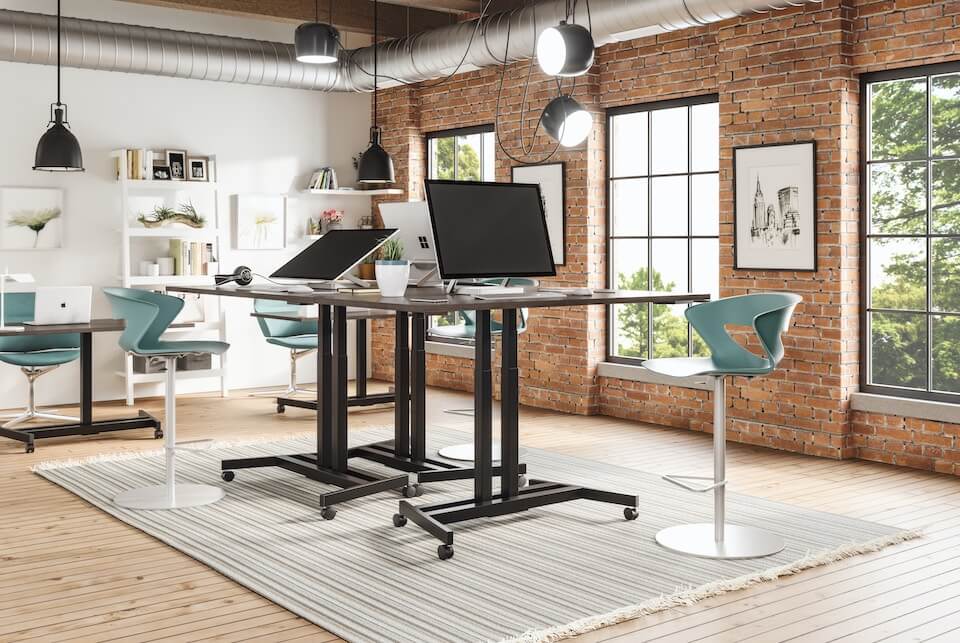Research has shown that one in three workers in 17 of the world’s most important economies aren’t engaged with their work. This is a big problem. Why? Because disengaged workers are unproductive and their attitude can also have a negative effect on those around them.
The good news? You can engage your employees and boost office productivity by designing your office with good employee engagement in mind.
Offer a range of spaces
Study after study has found that the number one issue in office productivity is that employees feel a lack of control over their work environment. Overcome this by giving staff a choice.
“Whatever work you’re doing, there’s a preferred workspace that gives people choice and control over how and where they work and provides the support they need in terms of space, furniture, technology and tools,” says Catherine Gall, Paris-based Research Director for Steelcase WorkSpace Futures.
With some simple planning, you can offer your staff a range of environments in which to work. Everyone is different – some people will opt for a private area where they can focus on their work without being distracted, while others will work best in a bustling, collaborative environment.
By giving your employees more choice and ultimately more control over where they work, you can help them to be at their most productive.

Give your staff some privacy
Open plan offices are only becoming more popular. While there are undoubtedly many benefits to this – collaboration is the lifeblood of innovation – there will also be times when staff will need to work in private spaces where they can focus without interruption and may be just a place to gather their thoughts.
With the increasing popularity of open-plan offices, private spaces are in demand, by simply adding a couple of these spaces with your office this can have a positive impact on employee productivity.
At Penketh Interiors, we offer innovative products to support privacy in the workplace, such as Den by Ocee Design.
Designed to make open spaces more private, Den is a range is acoustically enhanced to minimise noise and distractions. Den aids productivity, meaning staff can get on with their work without distraction and allowing employees to focus.

Look at your meeting style
Look at your meeting style as a whole – how effectively is information shared in your meetings? Are those attending able to express their ideas freely? Are your meetings unnecessarily long?
Taking a good, hard look at the meeting style you have become accustomed to will likely uncover several areas for improvement. Quite often there will be simpler ways of doing things, whether that is employing useful technology, or simply getting a meeting agenda in place that could cut your meeting times in half.
There are a whole host of products that allow colleagues to easily share ideas, from multiple screens, making the process much quicker and easier.
The impressive Clickshare allows staff to work seamlessly with colleagues from one screen. It’s quick to set up and so easy to use, with the option to connect up to 8 people in one meeting. There is no software to be downloaded and staff can easily connect via the app.
 For quick meetings on the go, consider Ballo. A great piece of furniture which can be placed next to a desk for impromptu meetings, the impressive, light-weight and super-comfortable Ballo can go where you go.
For quick meetings on the go, consider Ballo. A great piece of furniture which can be placed next to a desk for impromptu meetings, the impressive, light-weight and super-comfortable Ballo can go where you go.
Ensure that your staff take some time out
As the busy working day unfolds it’s easy to forget that your staff should take some time out to relax and be at their most productive. Even a quick 20-minute lunchbreak can make a big difference to their afternoon performance.
There are three types of staff wellbeing that are important to consider here, which are detailed below:
Physical wellbeing – this type of wellbeing focuses on how staff can physically work better, perhaps through using ergonomic products with increased options for movement during the working day, such as the Gesture chair, or innovative sit-stand desk.
Emotional wellbeing – this type of wellbeing looks at how your staff are feeling. If staff come to work with a positive state of mind, they will be highly engaged employees. Why not try a Work Café? These dynamic third spaces can better connect staff with their colleagues, the business and their own work. Your staff will bounce back more energised and productive as a result.
Cognitive wellbeing – this type of wellbeing is all about how to make sure your staff are mentally prepared to be at their best at work. The University of California estimates that the average office worker is distracted every 3 minutes, so it is important to create areas within the office for staff to focus with minimum disruption.

